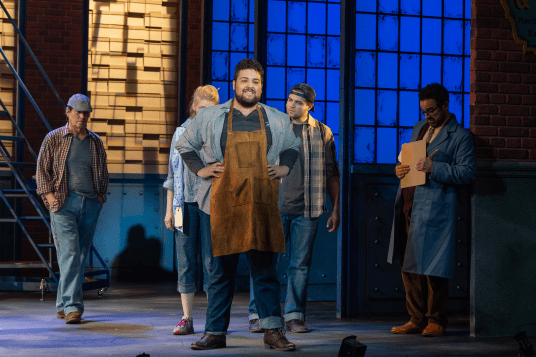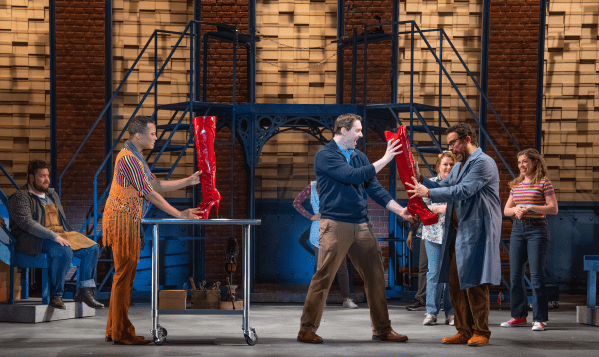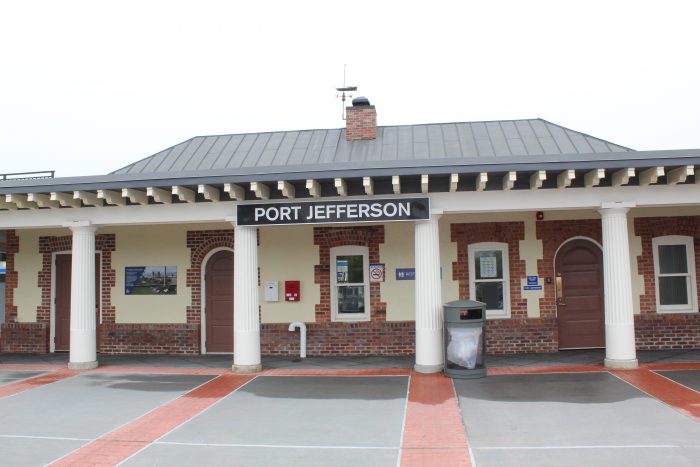Yearly Archives: 2022
Comsewogue Warriors corral Bulls in Suffolk Class B title game


















It took the Comsewogue Warriors four minutes into the fourth quarter to take the first lead of the game only to have the Bulls of Smithtown West retie the game at 6-6 on the ensuing possession.
With 4 minutes, 5 seconds left on the clock, James Krieg stretched the net to edge ahead by one when Michael Katz on a defensive take away scored the insurance goal a minute later to win the Suffolk Class B boy’s lacrosse final, 8-6, at East Islip High School June 1.
Katz scored three goals in the victory, Dylan Rocchio had two goals and an assist and teammates Brayden Arias, Thomas Kennedy and James Krieg each scored. Adam Wachholder had back-to-back saves in the closing minute for seven stops on the day.
The win propels the Warriors to the Long Island Championship round where they’ll face Garden City at Hofstra University June 4 with a 3 p.m. start.
Theater Review: ‘Kinky Boots’ struts its stuff at the Engeman




By Barbara Anne Kirshner
SHOES! Cobbled into laced high-top boots, stilettos or platforms, they transport the wearer to another place, another time, even another attitude. As Cyndi Lauper’s lyrics put it, “The most beautiful thing in the world — SHOES!”
Kinky Boots isn’t just about shoes; there’s a much deeper message of acceptance that resonates in this musical with book by Broadway icon, Harvey Fierstein (Torch Song Trilogy and La Cage aux Folles), and music and lyrics by Cyndi Lauper who already was the beacon for diversity with such anthems as True Colors. Together they crafted this poignant, funny musical that radiates so much heart.
The show is based on the 2005 British film, Kinky Boots, which was inspired by a true story, the topic of a 1999 episode of the BBC2 documentary television series Trouble at the Top.
This musical centers around a young man, Charlie Price, who is struggling to save his family’s five-generations-long shoe factory in the small town of Northampton, England that he inherited from his father. He forms an unlikely alliance with a drag queen, Lola, and they produce a line of high-heeled alternative footwear for men and take their kinky boots to the runways of the international shoe show in Milan. Along the way, Charlie and Lola realize they are not that different.
Kinky Boots premiered at the Al Hirschfeld Theatre on April 4, 2013. It received 13 nominations and 6 Tony Awards including Best Musical, Best Actor for Billy Porter and Best Score for Cyndi Lauper giving her the distinction of being the first woman to win alone in that category. It closed on April 7, 2019.
Now the musical heads to the John W. Engeman Theater in Northport which enjoys a tradition of breathtaking professionalism and Kinky Boots only adds to its repertoire of fabulous theatre.
Musical direction by Jeff Cox keeps festivities energized with the band conducted by Ben Kiley, on the night of this review, brilliantly taking on Lauper’s high-spirited score and driving it home.
The dynamic cast is intense and multi-talented, injecting passion and energy into the show. In the lead role of Charlie Price, Zach Hess is compelling, making us feel his dilemma, torn between trying to keep his father’s legacy alive or giving in to his fiancée Nicola’s insistence that they start a new life in London. Hess’ vocals are rich and powerful in such numbers as Step One, Take What You Got and blows the roof off the house with the impassioned Soul of a Man. Sofie Flores’ Nicola is a steam-roller, prickly and conniving; she selfishly conjures up a plan to get Charlie out of the factory.
Omari Collins dazzles in the role of flamboyant drag queen Lola whom Charlie met after a chance encounter. Collins glamorously struts his stuff in such numbers as Land of Lola, Sex Is In The Heels and sends chills with his showstopper Hold Me In Your Heart. He is riveting when he confides how he didn’t live up to his father’s desire that he become a proper boxer.
We are thoroughly immersed in the duo of Charlie and Lola who come together to create all those kinky boots and along the way realize that above all else they must accept themselves, a revelation that resounds in I’m Not My Father’s Son.
In the role of factory worker Lauren, who comes up with the idea of footwear for a diversified market, Lily Kaufmann is so much fun especially when she regrets her poor choices in men with The History of Wrong Guys and is deliciously animated lusting after Charlie. As factory worker Don, Demetrio Alomar exudes the right flavor of gruff and macho especially when he rebuffs Lola leading to a pivotal confrontation.
The ensemble is incredibly limitless, bouncing through the kinetic choreography of Natalie Malotke. The factory workers are appropriately gritty in contrast to the sizzling Angels. How the Angels are able to perform all those gymnastic dance routines in sky high heels is incomprehensible!
Under the direction of Igor Goldin, this production soars with vitality and feeling. The ingenious set designed by Kyle Dixon emulates the industrial feel of this small town factory with its steel scaffolding that glides into various positions as each scene requires and features a slide conveyor belt for spitting out shoes. Jose Santiago’s lighting design with well-placed spots that add pathos causes shivers and excitement just at the right moments. Sound design by Joanna Lynne Staub is crisp with all levels expertly set.
The shining stars are the thigh-high kinky boots in a rainbow of colors and bedazzled in jewels compliments of prop designer Kristie Moschetta. Kurt Alger must have had such fun designing costumes and wigs for this show. Every time Lola and her Angels appear we are awed by form-fitting confections in red, leather and animal prints with coiffeurs piled high or exploding in curls.
The finale, Raise You Up/Just Be, splashes joy over the audience and ejects them from their seats into an enthusiastic standing ovation. One can’t help but leave the theatre exhilarated. The Engeman has hit a home run with this mesmerizing production of Kinky Boots. Don’t miss it.
The John W. Engeman Theater, 250 Main St., Northport presents Kinky Boots through July 3. The 2021-2022 season closes out with the musical On Your Feet The Story of Emilio and Gloria Estefan from July 14 to Aug. 28. Tickets range from $75 to 80 with free valet parking. To order, call 631-261-2900 or visit www.engemantheater.com.
Port Jeff mayor addresses benches and traffic near train station
Mayor Margot Garant has responded to concerns about seating availability at Port Jefferson train station.
The village mayor believes the issue of seating availability cannot be divorced from public safety. “We were getting a lot of complaints about the homeless population,” Garant said. “They were using the off and on ramps and sleeping in them. And our ridership — whether it was people from Port Jeff Station or Port Jeff village — they were complaining to us about the safety at that time of getting on and off the train, especially in the early mornings and in the evening hours.”
During the 2019 redesign of the Port Jefferson train station, the village had discussed both seating availability and public safety with Long Island Rail Road. During those deliberations, the mayor said LIRR had pitched an idea to add redesigned benches to prevent individuals from sleeping on them.
“The discussion was held at that time about what the renovation plans would look like and I believe they had commented to us that they were introducing some of these other types of benches which would allow for seating but don’t allow for overnight sleeping,” she said, adding, “Since then our complaints have gone down, I would say, like 85%.”
Despite the decline in complaints from residents, there remains the problem of user-friendliness at the station for some riders. As reported last week, there are only two outdoor seating areas at the station, which can present an unnecessary obstacle for people with disabilities and the elderly.‘So, yes, seating should be made available if they can’t sit inside the booth or they want to sit outside, but it may be the type of seating that does not allow for you to lie down on it and that’s for a reason.’ — Margot Garant
Garant acknowledged that greater accommodations at the station should be made to ensure these populations can rest comfortably while waiting for a train.
“I feel for the complications that people have,” she said. “So, yes, seating should be made available if they can’t sit inside the booth or they want to sit outside, but it may be the type of seating that does not allow for you to lie down on it and that’s for a reason.”
The quantity and style of seating at the station is largely determined by LIRR, according to the mayor. The decision to add armrests along the benches, however, was a coordinated decision between LIRR and the village to curb sleeping at the station.
“Yes, there was a conversation with respect to that because we’re trying to prevent people from using the station as a sleeping area,” Garant said. “There is a significant, conscious effort in making sure that when our ridership gets up there in the early morning to take the train to work, they are not having to step over people or deal with a certain population up there that’s going to panhandle and make them feel unsafe. That was a conversation that we had.”
Garant added that user-friendliness has not been part of her agenda primarily because she does not see the public demand to alter the present layout of the station.
“In three years, nobody has come to us at a public meeting or raised this as a concern of theirs that they feel that the station is not user-friendly for them,” she said. “It’s not something that was brought to our attention.” She added, “Since we worked with Pax Christi and the station was renovated, it’s been a very peaceful coexistence.”
Because the railroad is not a village property, the mayor also said she is limited in her ability to change the layout. However, she agreed that if this becomes a persistent problem for riders and residents, then she would coordinate with LIRR to remedy it.
“We will certainly discuss with the Long Island Rail Road — because it is not our property — what we can do together to try and alleviate that concern,” the mayor said. “I have to be honest, that concern has not come to my desk in over three years.”
Station Street
Questions surrounding the layout of the station will continue as the village embarks upon its latest project to introduce Station Street, a one-way thoroughfare that will begin at Main Street, cut east near the parking lot and end at Oakland Street. This planned terminal will mitigate congestion on Route 112 and facilitate traffic coming in and out of the station.

 The Station Street project has been in the works since 2016, when the village approved a master plan to revitalize Upper Port. As part of joint efforts between the village, the Town of Brookhaven, LIRR and the state Department of Transportation, the proposed Station Street would create a plaza that will help channel traffic from the main thoroughfare, alleviating congestion as drivers enter the village.
The Station Street project has been in the works since 2016, when the village approved a master plan to revitalize Upper Port. As part of joint efforts between the village, the Town of Brookhaven, LIRR and the state Department of Transportation, the proposed Station Street would create a plaza that will help channel traffic from the main thoroughfare, alleviating congestion as drivers enter the village.
“We did a traffic study,” Garant said. “The traffic study and the DOT comments said the more that we can get people off of Route 112 as they’re going toward the east to work at the hospital, the better.” She added, “That will eliminate a lot of the buildup, the people waiting in line to get into Port Jeff village.”
The plan, if implemented, would eliminate two traffic concerns for the village. First it would relocate the bus stop currently placed along the train crossing into Station Street, eliminating a public safety hazard for people getting off of the bus. Relocating the bus stop will “make it much safer, get the pedestrians off that train intersection there and alleviate the traffic,” Garant said.
The plans would also introduce a driveway into the train station parking lot, where taxis and cars will have a better drop-off and pickup area. Behind the scenes, these plans are falling into place, according to Garant. Although still without a developer, the plans have been put out to bid and contracts are expected soon.
“The bid is out right now for contractors to come in and do the installation of that street,” the mayor said. “Everything is lining up and the plan is coming to fruition as we speak.”
Teen arrested for Commack school threat
Suffolk County Police on June 3 arrested a teenager after he made a threat on social media regarding a school in Commack.
A 15-year-old made a threat on Instagram Live on May 31 threatening violence at Commack Middle School, located at 700 Vanderbilt Parkway.
Following an investigation, Second Squad detectives, with assistance from Second Precinct Crime Section officers, arrested the teen at the Second Precinct in Huntington.
The 15-year-old, who was not a student at the school, was charged with Making a Terrorist Threat and Aggravated Harassment 2nd Degree. He was scheduled for arraignment at Family Court today.
Medical Compass: Alcohol — yes or no?
Family history and disease risk play big roles
By David Dunaief, M.D.

Is drinking alcohol good for you or bad for you? It’s one of the most widely used over-the-counter drugs, and yet there is still confusion over whether it benefits or harms to your health. The short answer: it depends on your circumstances, including your family history and consideration of diseases you are at high risk of developing.
Several studies tout alcohol’s health benefits, while others warning of its risks. The diseases addressed by these studies include breast cancer, heart disease and stroke. Remember, context is the determining factor when evaluating alcohol consumption.
Weighing Breast Cancer Risk
In a meta-analysis of 113 studies, there was an increased risk of breast cancer with daily consumption of alcohol (1). The increase was a modest, but statistically significant, four percent, and the effect was seen at one drink or less a day. The authors warned that women who are at high risk of breast cancer should not drink alcohol or should drink it only occasionally.

It was also shown in the Nurses’ Health Study that drinking three to six glasses a week increases the risk of breast cancer modestly over a 28-year period (2). This study involved over 100,000 women. Even a half-glass of alcohol was associated with a 15 percent elevated risk of invasive breast cancer. The risk was dose-dependent, with one to two drinks per day increasing risk to 22 percent, while those having three or more drinks per day had a 51 percent increased risk.
Alcohol’s impact on breast cancer risk is being actively studied, considering types of alcohol, as well as other mitigating factors that may increase or decrease risk. We still have much to learn.
Based on what we think we know, if you are going to drink, a drink several times a week may have the least impact on breast cancer. According to an accompanying editorial, alcohol may work by increasing the levels of sex hormones, including estrogen, and we don’t know if stopping diminishes the effect, although it might (3).
Effect on Stroke Risk
On the positive side, the Nurses’ Health Study demonstrated a decrease in the risk of both ischemic (caused by clots) and hemorrhagic (caused by bleeding) strokes with low to moderate amounts of alcohol (4). This analysis involved over 83,000 women. Those who drank less than a half-glass of alcohol daily were 17 percent less likely than nondrinkers to experience a stroke. Those who consumed one-half to one-and-a-half glasses a day had a 23 percent decreased risk of stroke, compared to nondrinkers.
However, women who consumed more experienced a decline in benefits, and drinking three or more glasses daily resulted in a non-significant increased risk of stroke. The reasons for alcohol’s benefits in stroke have been postulated to involve an anti-platelet effect (preventing clots) and increasing HDL (“good”) cholesterol. Patients should not drink alcohol solely to get stroke protection benefits.
If you’re looking for another option to achieve the same benefits, an analysis of the Nurses’ Health Study recently showed that those who consumed more citrus fruits had approximately a 19 percent reduction in stroke risk (5).
The citrus fruits used most often in this study were oranges and grapefruits. Note that grapefruit may interfere with medications such as Plavix (clopidogrel), a commonly used antiplatelet medication used to prevent strokes (6).
Effect on Heart Attack Risk
In the Health Professionals follow-up study, there was a substantial decrease in the risk of death after a heart attack from any cause, including heart disease, in men who drank moderate amounts of alcohol compared to those who drank more or were non-drinkers (7). Those who drank less than one glass daily experienced a 22 percent risk reduction, while those who drank one-to-two glasses saw a 34 percent risk reduction. The authors mention that binge drinking negates any benefits. This study has a high durability spanning 20 years.
What’s the Answer?
Moderation is the key. It is important to remember that alcohol is a drug that does have side effects, including insomnia. The American Heart Association recommends that women drink up to one glass a day of alcohol. I would say that less is more. To get the stroke benefits and avoid the increased breast cancer risk, half a glass of alcohol per day may be the ideal amount for women. Moderate amounts of alcohol for men are up to two glasses daily, though one glass showed significant benefits.
Remember, there are other ways of reducing your risks that don’t require alcohol. However, if you enjoy it, modest amounts may reap some health benefits.
References:
(1) Alc and Alcoholism. 2012;47(3)3:204–212. (2) JAMA. 2011;306:1884-1890. (3) JAMA. 2011;306(17):1920-1921. (4) Stroke. 2012;43:939–945. (5) Stroke. 2012;43:946–951. (6) Medscape.com. (7) Eur Heart J. Published online March 28, 2012.
Dr. David Dunaief is a speaker, author and local lifestyle medicine physician focusing on the integration of medicine, nutrition, fitness and stress management. For further information, visit www.medicalcompassmd.com.
One-on-one with Ana Hozyainova
Port Jeff village trustee candidate on her global approach to local issues
Ana Hozyainova is a candidate for trustee in the upcoming village election on June 21. During a recent interview, she discussed her background in social work, her experiences abroad, the threat of climate change to Port Jeff village, the East Beach Bluff and more.
What is your background and why would you like to be involved in local government?
I would like to answer that in reverse order — why I would like to run and then how my background is beneficial in the service to the village.
One of the key things is that I would like to build upon and preserve the legacy that the village has already created. I see that the village, just like the rest of the nation and other municipalities, faces a number of challenges that are way outside of our control. For example, we are a coastal community that will suffer significantly with the worsening impact of climate change. The flooding will become only worse.

We are a community that changes in its residential structure. The nation is aging and the nation is shrinking in certain ways, and this will have an impact on the village and the way the village works. We also as a village observed decline in our tax revenue, mainly through the LIPA gliding path. Any one of those challenges is already an issue that would require significant adjustment, but three of them together compound the issue and require a long-term vision and long-term solutions to the way the village functions.
I hope to be able to engage in that process because I would like to make Port Jefferson my long-term home. I have a family here and I would like that family to continue to grow and stay in the village. For me, the role of the trustee is a person who sets the policies, sets standards and hires people to implement those policies. This is where I believe my skills and my background are incredibly useful for the village.
I come with nearly two decades of experience of human rights work, international work. I worked in fields as diverse as countering violent extremism to working with mental health issues to doing community organizing to developing policies to address such thorny issues as: How do we still torture?

The issues I mentioned before are very difficult to address and they require creative thinking and problem-solving in order to develop a viable, functional solution. I believe that I have those solutions. I also have an education that is very helpful for that with a degree in social work from Columbia University. Part of the reason that I chose that school is that at the core of the teaching in my school, the person was put front and center.
With a lot of the political decisions — be it raising of the taxes or changes in the code or restructuring the zoning of the village — it is very easy to forget the human that will be impacted by those decisions. I have the skills that would be required to actually look at who would be those people who would be affected and what can we do to make sure that our decisions serve the greatest good of everyone involved, that we’re not just doing quick and dirty “let’s fix this” and forget about the unintended consequences that might come out of those decisions.

Given your experiences abroad, why did you turn your focus inward toward local issues?
Again going back to my time at Columbia University — and the reason I mention it is because when I was there, I found it incredibly frustrating when my teachers would say, “Think small. Think of the impact that certain actions would have on people at the local level. Engage with the small steps first. Don’t try to change the whole system at the same time. It will become overwhelming and unmanageable. Think about issues that affect people on the ground, and from there start building up your intervention.”
As the years passed by, I’ve learned — despite my frustrations — that that’s indeed the true way to bring real change into the lives of the people. At the moment, my residency ended up in Port Jefferson by virtue of the people who I met, the person who I married. I feel that the work that can be done at the local level is no less important than any of the work that I could have done elsewhere. Right now, the moment has brought me to Port Jefferson and this is where my skills can be most useful and could be applied right now.
You have been a vocal proponent of reconfiguring roadways in the village. In your opinion, what is wrong with these roadways and how can they be improved?
The issue of walkability in Port Jefferson, especially pedestrian safety, is an issue that is very dear to me. I live in a residential neighborhood with two main roads that kind of hug the area. I walk those streets every day and I personally experience the impacts that speeding cars or reckless driving could have on pedestrians.
It is the issue that I personally experience and that’s how I start organizing the work. I’ve heard too many people say this is dangerous and unsustainable, that they’re fearful of walking but it’s the only exercise that they have. So I rallied the community for stop signs on California Avenue as an interim measure to assess what other possible solutions can be brought in to improve pedestrian safety.
As I did that work, I also got in touch with other residents in the village who also voiced their concerns and discovered that it is a systematic problem, that many people face issues about safety on the roads. What I hope to do is a systematic assessment of what can be done in Port Jefferson to make it more walkable as a village because our ability to walk is one of the prerequisites for developing strong, friendly communities. That is how my activism on pedestrian safety has started.
The issues that I would like to address if I were elected are the questions of transparency in the village.
— Ana Hozyainova
What are the most critical issues facing the village?

I mentioned earlier that climate change, the change and declining population nationwide and the lowering of the tax base are the crucial aspects that we are facing as a village. The issues that I would like to address if I were elected are the questions of transparency in the village.
By this, I mean that we have a number of pretty large projects that are developing in the village that have not received adequate public consultation, and the village has not made the effort to engage the community in the level that it should have. For example, the question of the $10 million that was borrowed to stabilize the [East Beach] Bluff. I personally have a lot of questions about how the project was designed, what other issues have been explored or addressed, also to hear what the rest of the residents want to say or have priorities for, and how they conceptualize and prioritize that as an issue.
I believe that the village has not had adequate engagement on those issues. The presentation on the bluff is available on YouTube, but that information does not adequately reflect the complexity of the issues that we are facing. For example, when we have a Dickens Festival, we don’t just publish a legal notice that there will be a festival and forget about it. We actually make a campaign, we engage people, we invite people over and over and over again, and the festival is a success.
So similar things need to happen when we are making decisions about the village such as the bluff or as small as figuring out the budget. What are the priorities for spending that would be in the residents’ interests? Transparency is one of the core areas to be developed if I were elected.
The other issue is climate change. Coming back to the question of the bluff, part of the reason why we have this situation is the way that climate change is exacerbating the storms and thus speeding up the erosion of the bluff. It’s a man-made issue: The harbor where the bluff sits used to be salt marshes. The movement of water in the salt marshes is significantly slower than in the dredged marshes that created Mount Sinai Harbor, which subsequently affected our bluff.
We are dealing with a double whammy of the harbor that we’ve created. I love this beach, I enjoy having access to that beach, but that beach is exacerbating the erosion of the bluff along with the more severe storms. I believe we will need a greater consultation about how we spend the rest of the money that has already been allocated for the upper part of the bluff. If elected, that will definitely become one of my priorities.
How can residents play a more active role in decision-making?
Part of it is the way the village engages with the village. For example, the Village of Port Jefferson doesn’t have a civic association. It has a range of working committees, but it doesn’t have a civic association that will collect or take the views of residents who might not be able to attend the public meetings held once a month at 6 o’clock.
Until I became engaged in the traffic safety issues, I found it very difficult to make my way to those meetings. It’s only after I rallied the community and took on the weight of their trust that I started making the time to go to those meetings.
If I were elected, I would explore a range of issues to engage more with the residents. One of them would be, for example, having a weekly time slot at the farmers market where one trustee can man a booth every week, so the residents wouldn’t have to go out of their way to engage the government. At the moment, I feel that the local village government is not doing enough to engage with the residents.

Is there anything else you would like to say to our readers?
To summarize my message, I believe that I possess the skills and experience that are required to serve as a trustee. If elected, I would be putting the residents front and center of my work in making sure that they are consulted and engaged, and that the best interests of all of the residents are considered.
Pond Path property on planning board’s agenda
On the agenda for the Town of Brookhaven Planning Board June 6 meeting is an eight-lot preliminary subdivision with cul-de-sac and drainage basin located at the southeast corner of Pond Path and Upper Sheep Pasture Road in East Setauket.
A decision on the application submitted by Anthony Martino, president of Winmar Homes based in Ronkonkoma, was tabled at the planning board’s May 16 meeting.
The approximately 6 1/2 acre property, zoned as residential, is one that the Three Village Civic Association has been keeping an eye on. At a meeting earlier this year, members were given an update on the parcel. According to the civic’s land use chair, Herb Mones, the wish is that a “more responsible site development can be submitted.”
Known locally as the Selleck property, Mones said it is the last local farm south of Route 25A. On the property is a 1920s farmhouse that the civic wants protected and not demolished. Members also hope that the newly built homes will be clustered, leaving more than 2 acres to be preserved.
Last year it was determined that the property was sufficient for nine lots according to L.K. McLean Associates of Brookhaven.
The Brookhaven Highway Department, in a letter to the planning division last year, made several recommendations, including curbing and sidewalks on Pond Path and Upper Sheep Pasture Road and removing/replacing the existing curb on Pond Path at the intersection.
Last November, representatives from the Three Village Civic Association met with developers.
According to the civic, the parcel, which is near Nassakeag Elementary School and the town-owned Merritt-Hawkins House, was once part of the Merritt-Hawkins farmland.
The Town of Brookhaven Planning Board meeting can be viewed on the town’s website, www.brookhavenny.gov, or attended in person. The meeting begins at 4 p.m. on June 6.
Theatre Three seeks ushers for main stage and children’s shows
Volunteers wanted
Theatre Three, 412 Main St., Port Jefferson seeks volunteers to serve as ushers for its upcoming shows. As an usher, you will help seat guests, sell raffle tickets and see a show for free! Openings are available for all of the theater’s Main Stage productions and Children’s Theatre performances. You can volunteer as often as you like. All Theatre Three staff and volunteers are required to be fully vaccinated and at least 16 years of age or older. Call 631-928-9100.
American Legion Post 432 honors the fallen on Memorial Day
Members of the American Legion Post 432, based out of Port Jefferson Station, held a series of services throughout the community to honor the sacrifices made by American servicemen.
The day began at Steven J. Crowley Memorial Park in Terryville. Cpl. Crowley was a security guard for the United States Marines. In 1979 Crowley made the ultimate sacrifice when he died in the line of duty when the U.S. Embassy in Islamabad, Pakistan, was besieged by a student riot.
Kevin Powers, sergeant at arms at Post 432, grew up with Crowley. The two later served together in the Marine Corps.
“He was a good man,” Powers said. “I knew Steven since elementary school and we graduated together. I miss him dearly.”
The memorial service at Crowley Park is an annual tradition at the post. Powers suggested that this event is a yearly reminder of Crowley’s legacy of service and helps to keep a fallen comrade’s memory alive.
 “We do this every year,” he said. “It’s an honor to do that for him and for all of the men and women in the service who gave their lives to protect our freedom.”
“We do this every year,” he said. “It’s an honor to do that for him and for all of the men and women in the service who gave their lives to protect our freedom.”
Ron Romaszka, commander of Post 432, reflected upon his own experiences during the Vietnam War and his brothers in arms who died in combat.
“I lost a lot of guys over in ‘Nam,” he said. “I don’t talk about it all the time. That’s mine and I keep that inside.” On the importance of the day in hand, he added, “Memorial Day has always been a very important day for me. For all of the veterans here, they all have a special feeling inside, and that’s why it’s an important day for all of us.”
Romaszka also touched upon the role of the American Legion in serving veterans throughout the community. “We stand behind every veteran that’s out there,” the post commander said. “For any veteran that needs assistance of any kind, we’re there to assist them. Whether it’s financial, whether it’s medical — whatever it is, we’re there for them.”
The post held a similar ceremony at the Port Jefferson Memorial Park in the village. Trustee Bruce Miller, who also serves as 2nd vice commander of Post 432, shared that freedom is inextricably linked to the sacrifices of American veterans.
village. Trustee Bruce Miller, who also serves as 2nd vice commander of Post 432, shared that freedom is inextricably linked to the sacrifices of American veterans.
“We come to honor the fallen on Memorial Day,” he said. “It is important to look back and remember that our freedom is not free, that we have our freedom because people have fought and died for it.” He added, “It is important to recognize their sacrifice and the sacrifices of those serving today.”
While it may be a solemn occasion, Miller said veterans can find solace this Memorial Day in knowing that American forces are not currently in the line of fire.
“This is the first year in the last 20 that we are not at war,” the village trustee said. “Veterans can rejoice that none of our soldiers, sailors or marines are coming under fire. But as the Ukrainians have shown us, we must always be ready.”
‘Port Jefferson is a great place to live and people have worked hard to create that freedom. I’m very thankful for their service, for those who have lost their lives, and we honor them.’
— Margot Garant
Mayor Margot Garant offered her own take on Memorial Day. She said she witnessed firsthand the sacrifices of American veterans as several of her family members, including her brother and father, have served.
“I feel that every day in our community is Memorial Day,” she said. “It gives us a time to pause and remember and be thankful for all of the great things that we have.” The village mayor added, “Port Jefferson is a great place to live and people have worked hard to create that freedom. I’m very thankful for their service, for those who have lost their lives, and we honor them.”
 The day concluded with one last service at the post, followed by refreshments. To learn more about Post 432 and its various offerings, visit www.americanlegionwilsonritchpost432.org.
The day concluded with one last service at the post, followed by refreshments. To learn more about Post 432 and its various offerings, visit www.americanlegionwilsonritchpost432.org.
— Photos by Raymond Janis








































